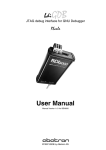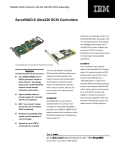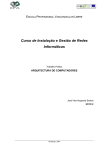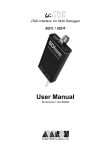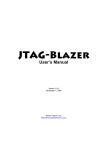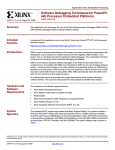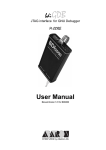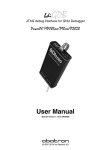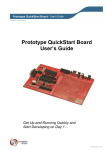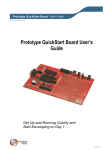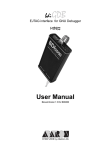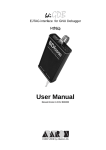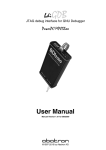Download bdiGDB User Manual
Transcript
bdi GDB
JTAG interface for GNU Debugger
XScale
User Manual
Manual Version 1.08 for BDI2000
©1997-2006 by Abatron AG
bdiGDB for GNU Debugger, BDI2000 (XScale)
User Manual
2
1 Introduction ................................................................................................................................. 4
1.1 BDI2000................................................................................................................................. 4
1.2 BDI Configuration .................................................................................................................. 5
2 Installation ................................................................................................................................... 6
2.1 Connecting the BDI2000 to Target......................................................................................... 6
2.1.1 Changing Target Processor Type ................................................................................. 8
2.2 Connecting the BDI2000 to Power Supply............................................................................. 9
2.2.1 External Power Supply ................................................................................................. 9
2.2.2 Power Supply from Target System ............................................................................. 10
2.3 Status LED «MODE»........................................................................................................... 11
2.4 Connecting the BDI2000 to Host ......................................................................................... 12
2.4.1 Serial line communication .......................................................................................... 12
2.4.2 Ethernet communication ............................................................................................ 13
2.5 Installation of the Configuration Software ............................................................................ 14
2.5.1 Configuration with a Linux / Unix host........................................................................ 15
2.5.2 Configuration with a Windows host ............................................................................ 17
2.5.3 Recover procedure..................................................................................................... 18
2.6 Testing the BDI2000 to host connection .............................................................................. 19
2.7 TFTP server for Windows NT............................................................................................... 19
3 Using bdiGDB ............................................................................................................................ 20
3.1 Principle of operation........................................................................................................... 20
3.2 Configuration File ................................................................................................................ 21
3.2.1 Part [INIT]................................................................................................................... 22
3.2.2 Part [TARGET] ........................................................................................................... 24
3.2.3 Part [HOST]................................................................................................................ 28
3.2.4 Part [FLASH] .............................................................................................................. 29
3.2.5 Part [REGS] ............................................................................................................... 33
3.3 Debugging with GDB ........................................................................................................... 35
3.3.1 Target setup................................................................................................................ 35
3.3.2 Connecting to the target............................................................................................. 35
3.3.3 Breakpoint Handling................................................................................................... 36
3.3.4 GDB monitor command.............................................................................................. 36
3.3.5 Debug handler............................................................................................................ 37
3.3.6 Target serial I/O via BDI ............................................................................................. 38
3.4 Telnet Interface .................................................................................................................... 39
3.4.1 Command list ............................................................................................................. 40
3.4.2 CPxx Registers .......................................................................................................... 41
3.5 Multi-Core Support .............................................................................................................. 42
4 Specifications ............................................................................................................................ 43
5 Environmental notice ................................................................................................................ 44
6 Declaration of Conformity (CE) ................................................................................................ 44
7 Warranty ..................................................................................................................................... 45
© Copyright 1997-2006 by ABATRON AG Switzerland
V 1.08
bdiGDB for GNU Debugger, BDI2000 (XScale)
User Manual
3
7 Appendices
A Troubleshooting ........................................................................................................................ 46
B Maintenance .............................................................................................................................. 47
C Trademarks ................................................................................................................................ 49
© Copyright 1997-2006 by ABATRON AG Switzerland
V 1.08
bdiGDB for GNU Debugger, BDI2000 (XScale)
User Manual
4
1 Introduction
bdiGDB enhances the GNU debugger (GDB), with JTAG debugging for XScale based targets. With
the builtin Ethernet interface you get a very fast download speed of up to 250 kBytes/sec. No target
communication channel (e.g. serial line) is wasted for debugging purposes. Even better, you can use
fast Ethernet debugging with target systems without network capability. The host to BDI communication uses the standard GDB remote protocol.
An additional Telnet interface is available for special debug tasks (e.g. force a hardware reset,
program flash memory, ... ).
The following figure shows how the BDI2000 interface is connected between the host and the target:
Target System
XScale
JTAG Interface
BDI2000
UNIX / PC Host
GNU Debugger
(GDB)
Abatron AG
Swiss Made
Ethernet (10 BASE-T)
1.1 BDI2000
The BDI2000 is the main part of the bdiGDB system. This small box implements the interface between the JTAG pins of the target CPU and a 10Base-T ethernet connector. The firmware and the
programable logic of the BDI2000 can be updated by the user with a simple Windows / Linux based
configuration program. The BDI2000 supports 1.8 – 5.0 Volts target systems (3.0 – 5.0 Volts target
systems with Rev. A/B).
.
© Copyright 1997-2006 by ABATRON AG Switzerland
V 1.08
bdiGDB for GNU Debugger, BDI2000 (XScale)
User Manual
5
1.2 BDI Configuration
As an initial setup, the IP address of the BDI2000, the IP address of the host with the configuration
file and the name of the configuration file is stored within the flash of the BDI2000.
Every time the BDI2000 is powered on, it reads the configuration file via TFTP.
Following an example of a typical configuration file:
; bdiGDB configuration file for IQ80310 board
; ------------------------------------------;
[INIT]
WCP15
0x2001
0x00000001 ;Disable Write Buffer Coalescing
;
; Init DRAM
WM32
0x00001508 0xA0000000 ;SDBR: Set SDRAM Base Address
WM32
0x00001504 0x00000AA0 ;SDCR: 1 single-sided DIMM
WM32
0x0000150C 0x00000008 ;SBR0: 1 bank 32MB
WM32
0x00001510 0x00000008 ;SBR1: 1 bank 32MB
WM32
0x00001568 0x00000000 ;RFR : Diables Refresh Cycle
WM32
0x00001500 0x00000003 ;SDIR: Issue NOP cmd to SDRAM
DELAY
10
;delay after the NOP command
WM32
0x00001568 0x00000600 ;RFR : Set Refresh Rate
WM32
0x00001500 0x00000002 ;SDIR: Precharge all
WM32
0x00001500 0x00000004 ;SDIR: Auto Refresh #1
........
WM32
0x00001500 0x00000004 ;SDIR: Auto Refresh #8
WM32
0x00001500 0x00000000 ;SDIR: Send Mode Reg Set Cmd with CAS Latency 2
WM32
0x00001500 0x00000006 ;SDIR: Issue aNormal Operation command
;
[TARGET]
CPUTYPE
JTAGCLOCK
DBGHANDLER
ENDIAN
BREAKMODE
IOP310
0
0xFFFF0000
LITTLE
SOFT
[HOST]
IP
FILE
FORMAT
LOAD
151.120.25.119
E:\cygwin\home\bdidemo\xscale\vxworks
BIN 0xA0020000
MANUAL
;load code code MANUAL or AUTO after reset
[FLASH]
WORKSPACE
CHIPTYPE
CHIPSIZE
BUSWIDTH
FILE
FORMAT
ERASE
ERASE
ERASE
ERASE
[REGS]
FILE
;the target CPU type
;use 16 MHz JTAG clock
;debug handler base address
;memory model (LITTLE | BIG)
;SOFT or HARD
0xa0020000 ;workspace in target RAM for fast programming algorithm
STRATAX8
;Flash type
0x800000
;The size of one flash chip in bytes
8
;The width of the flash memory bus in bits (8 | 16 | 32)
E:\cygwin\home\bdidemo\xscale\vxworks
BIN 0x00080000
0x00080000 ;erase sector 4
0x000A0000 ;erase sector 5
0x000C0000 ;erase sector 6
0x000E0000 ;erase sector 7
E:\cygwin\home\bdidemo\xscale\reg80310.def
Based on the information in the configuration file, the target is automatically initialized after every reset.
© Copyright 1997-2006 by ABATRON AG Switzerland
V 1.08
bdiGDB for GNU Debugger, BDI2000 (XScale)
User Manual
6
2 Installation
2.1 Connecting the BDI2000 to Target
The enclosed target cable is designed for the Intel recommended 20pin JTAG connector. In case
where the target system has an appropriate connector, the cable can be directly connected. The pin
assignment is in accordance with the Intel specification.
!
In order to ensure reliable operation of the BDI (EMC, runtimes, etc.) the target cable length must not
exceed 20 cm (8").
Rev. A
1
19
Target System
2
XScale
20
BDI2000
BDI
Abatron AG
TRGT MODE
BDI MAIN
9
1
10
2
BDI OPTION
Swiss Made
The green LED «TRGT» marked light up when target is powered up
Rev. B/C
1
19
Target System
2
XScale
BDI2000
BDI
Abatron AG
TRGT MODE
TARGET A
9
1
10
2
TARGET B
Swiss Made
The green LED «TRGT» marked light up when target is powered up
© Copyright 1997-2006 by ABATRON AG Switzerland
20
20 pin JTAG
Connector
1 - Vcc Target
2 - NC
3 - TRST
4 - NC
5 - TDI
6 - NC
7 - TMS
8 - GROUND
9 - TCK
10 - GROUND
11 - NC
12 - NC
13 - TDO
14 - NC
15 - RESET
16 - NC
17 - NC
18 - NC
19 - NC
20 - NC
20 pin JTAG
Connector
1 - Vcc Target
2 - NC
3 - TRST
4 - NC
5 - TDI
6 - NC
7 - TMS
8 - GROUND
9 - TCK
10 - GROUND
11 - NC
12 - NC
13 - TDO
14 - NC
15 - RESET
16 - NC
17 - NC
18 - NC
19 - NC
20 - NC
V 1.08
bdiGDB for GNU Debugger, BDI2000 (XScale)
User Manual
7
BDI MAIN / TARGET A Connector Signals
Pin
Name
Describtion
1
reserved
This pin is currently not used.
2
TRST
JTAG Test Reset
This open-drain / push-pull output of the BDI2000 resets the JTAG TAP controller on the
target. Default driver type is push-pull.
3+5
GND
System Ground
4
TCK
JTAG Test Clock
This output of the BDI2000 connects to the target TCK line.
6
TMS
JTAG Test Mode Select
This output of the BDI2000 connects to the target TMS line.
7
RESET
This open collector output of the BDI2000 is used to reset the target system.
8
TDI
JTAG Test Data In
This output of the BDI2000 connects to the target TDI line.
9
Vcc Target
1.8 – 5.0V:
This is the target reference voltage. It indicates that the target has power and it is also used
to create the logic-level reference for the input comparators. It also controls the output logic
levels to the target. It is normally connected to Vdd I/O on the target board.
3.0 – 5.0V with Rev. A/B :
This input to the BDI2000 is used to detect if the target is powered up. If there is a current
limiting resistor between this pin and the target Vdd, it should be 100 Ohm or less.
10
TDO
JTAG Test Data Out
This input to the BDI2000 connects to the target TDO line.
© Copyright 1997-2006 by ABATRON AG Switzerland
V 1.08
bdiGDB for GNU Debugger, BDI2000 (XScale)
User Manual
8
2.1.1 Changing Target Processor Type
Before you can use the BDI2000 with an other target processor type (e.g. XScale <--> PPC), a new
setup has to be done (see chapter 2.5). During this process the target cable must be disconnected
from the target system. The BDI2000 needs to be supplied with 5 Volts via the BDI OPTION connector (Rev. A) or via the POWER connector (Rev. B/C). For more information see chapter 2.2.1
«External Power Supply»).
!
To avoid data line conflicts, the BDI2000 must be disconnected from the target system while
programming the logic for an other target CPU.
© Copyright 1997-2006 by ABATRON AG Switzerland
V 1.08
bdiGDB for GNU Debugger, BDI2000 (XScale)
User Manual
9
2.2 Connecting the BDI2000 to Power Supply
2.2.1 External Power Supply
The BDI2000 needs to be supplied with 5 Volts (max. 1A) via the BDI OPTION connector (Rev. A)
or via POWER connector (Rev. B/C). The available power supply from Abatron (option) or the enclosed power cable can be directly connected. In order to ensure reliable operation of the BDI2000,
keep the power supply cable as short as possible.
!
For error-free operation, the power supply to the BDI2000 must be between 4.75V and 5.25V DC.
The maximal tolerable supply voltage is 5.25 VDC. Any higher voltage or a wrong polarity
might destroy the electronics.
Rev. A
BDI OPTION
Connector
BDI
TRGT MODE
BDI MAIN
BDI OPTION
13
1
2
14
Vcc
GND
The green LED «BDI» marked light up when 5V power is connected to the BDI2000
B/C
Rev. B
Version
GND 3
RS232
BDI
TRGT MODE
POWER
Connector
1 Vcc
2
4
POWER
LI
TARGET A
1 - NOT USED
2 - GROUND
3 - NOT USED
4 - GROUND
5 - NOT USED
6 - GROUND
7 - NOT USED
8 - GROUND
9 - NOT USED
10 - GROUND
11 - NOT USED
12 - Vcc (+5V)
13 - Vcc Target (+5V)
14 - Vcc (+5V)
TX RX
10 BASE-T
1 - Vcc (+5V)
2 - VccTGT
3 - GROUND
4 - NOT USED
TARGET B
The green LED «BDI» marked light up when 5V power is connected to the BDI2000
Please switch on the system in the following sequence:
• 1 --> external power supply
• 2 --> target system
© Copyright 1997-2006 by ABATRON AG Switzerland
V 1.08
bdiGDB for GNU Debugger, BDI2000 (XScale)
User Manual
10
2.2.2 Power Supply from Target System
The BDI2000 needs to be supplied with 5 Volts (max. 1A) via BDI MAIN target connector (Rev. A) or
via TARGET A connector (Rev. B/C). This mode can only be used when the target system runs with
5V and the pin «Vcc Target» is able to deliver a current up to 1A@5V. For pin description and layout
see chapter 2.1 «Connecting the BDI2000 to Target». Insert the enclosed Jumper as shown in figure
below. Please ensure that the jumper is inserted correctly.
!
For error-free operation, the power supply to the BDI2000 must be between 4.75V and 5.25V DC.
The maximal tolerable supply voltage is 5.25 VDC. Any higher voltage or a wrong polarity
might destroy the electronics.
Rev. A
BDI OPTION
Connector
BDI
TRGT MODE
BDI MAIN
BDI OPTION
1
13
2
14
Jumper
The green LEDs «BDI» and «TRGT» marked light up when target is powered up
and the jumper is inserted correctly
Rev. B/C
3
RS232
BDI
TRGT MODE
POWER
Connector
1
2
4
POWER
1 - NOT USED
2 - GROUND
3 - NOT USED
4 - GROUND
5 - NOT USED
6 - GROUND
7 - NOT USED
8 - GROUND
9 - NOT USED
10 - GROUND
11 - NOT USED
12 - Vcc (+5V)
13 - Vcc Target (+5V)
14 - Vcc BDI2000 (+5V)
Jumper
LI
TARGET A
TX RX
10 BASE-T
1 - Vcc BDI2000 (+5V)
2 - Vcc Target (+5V)
3 - GROUND
4 - NOT USED
TARGET B
The green LEDs «BDI» and «TRGT» marked light up when target is powered up
and the jumper is inserted correctly
© Copyright 1997-2006 by ABATRON AG Switzerland
V 1.08
bdiGDB for GNU Debugger, BDI2000 (XScale)
User Manual
11
2.3 Status LED «MODE»
The built in LED indicates the following BDI states:
Rev. A
BDI
TRGT MODE
BDI MAIN
BDI OPTION
Rev. B/C
BDI
TRGT MODE
TARGET A
MODE LED
TARGET B
BDI STATES
OFF
The BDI is ready for use, the firmware is already loaded.
ON
The power supply for the BDI2000 is < 4.75VDC.
BLINK
The BDI «loader mode» is active (an invalid firmware is loaded or loading firmware is active).
© Copyright 1997-2006 by ABATRON AG Switzerland
V 1.08
bdiGDB for GNU Debugger, BDI2000 (XScale)
User Manual
12
2.4 Connecting the BDI2000 to Host
2.4.1 Serial line communication
Serial line communication is only used for the initial configuration of the bdiGDB system.
The host is connected to the BDI through the serial interface (COM1...COM4). The communication
cable (included) between BDI and Host is a serial cable. There is the same connector pinout for the
BDI and for the Host side (Refer to Figure below).
Rev. A
RS232 Connector
(for PC host)
Target System
12345
XScale
DSR
DCD
4
4
CTS
1
1
DTR
RTS
6
6
DCD
RS232
8
8
DSR
6789
LI
TX
RX
10 BASE-T
TD
7
CTS
RD
3
7
RTS
GND
2
3
TD
5
2
RD
5
GND
DTR
BDI2000
PC Host
Abatron AG
Swiss Made
RS232
Rev. B/C
Target System
RS232 Connector
12345
XScale
(for PC host)
CTS
6
DSR
1
DCD
4
4
RTS
8
1
DTR
6789
RS232
POWER
LI
TX RX
10 BASE-T
TD
7
6
DCD
RD
3
8
DSR
GND
2
CTS
5
7
RTS
3
TD
2
RD
5
GND
DTR
BDI2000
PC Host
Abatron AG
Swiss Made
RS232
© Copyright 1997-2006 by ABATRON AG Switzerland
V 1.08
bdiGDB for GNU Debugger, BDI2000 (XScale)
User Manual
13
2.4.2 Ethernet communication
The BDI2000 has a built-in 10 BASE-T Ethernet interface (see figure below). Connect an UTP (Unshilded Twisted Pair) cable to the BD2000. For thin Ethernet coaxial networks you can connect a
commercially available media converter (BNC-->10 BASE-T) between your network and the
BDI2000. Contact your network administrator if you have questions about the network.
Rev. A
1
8
10 BASE-T
Connector
1 - TD+
2 - TD3 - RD+
4 - NC
5 - NC
6 - RD7 - NC
8 - NC
RS232
LI
TX
RX
10 BASE-T
Target System
Rev. B/C
1
RS232
POWER
LI
TX RX
8
XScale
10 BASE-T
BDI2000
PC Host
Abatron AG
Swiss Made
Ethernet (10 BASE-T)
The following explains the meanings of the built-in LED lights:
LED
Name
Description
LI
Link
When this LED light is ON, data link is successful between the UTP
port of the BDI2000 and the hub to which it is connected.
TX
Transmit
When this LED light BLINKS, data is being transmitted through the UTP
port of the BDI2000
RX
Receive
When this LED light BLINKS, data is being received through the UTP
port of the BDI2000
© Copyright 1997-2006 by ABATRON AG Switzerland
V 1.08
bdiGDB for GNU Debugger, BDI2000 (XScale)
User Manual
14
2.5 Installation of the Configuration Software
On the enclosed diskette you will find the BDI configuration software and the firmware required for
the BDI2000. For Windows NT users there is also a TFTP server included.
The following files are on the diskette.
b20xscgd.exe
Windows configuration program
b20xscgd.hlp
Windows help file for the configuration program
b20xscgd.xxx
Firmware for the BDI2000
xscjed20.xxx
JEDEC file for the BDI2000 (Rev. A/B) logic device when working with a XScale target
xscjed21.xxx
JEDEC file for the BDI2000 (Rev. C) logic device when working with a XScale target
tftpsrv.exe
TFTP server for WindowsNT/ Windows95 (WIN32 console application)
*.cfg
Configuration files
*.def
Register definition files
bdisetup.zip
ZIP Archive with the Setup Tool sources for Linux / UNIX hosts.
Overview of an installation / configuration process:
• Create a new directory on your hard disk
• Copy the entire contents of the enclosed diskette into this directory
• Linux only: extract the setup tool sources and build the setup tool
• Use the setup tool to load/update the BDI firmware/logic
Note: A new BDI has no firmware/logic loaded.
• Use the setup tool to transmit the initial configuration parameters
- IP address of the BDI.
- IP address of the host with the configuration file.
- Name of the configuration file. This file is accessed via TFTP.
- Optional network parameters (subnet mask, default gateway).
Activating BOOTP:
The BDI can get the network configuration and the name of the configuration file also via BOOTP.
For this simple enter 0.0.0.0 as the BDI’s IP address (see following chapters). If present, the subnet
mask and the default gateway (router) is taken from the BOOTP vendor-specific field as defined in
RFC 1533.
With the Linux setup tool, simply use the default parameters for the -c option:
[root@LINUX_1 bdisetup]# ./bdisetup -c -p/dev/ttyS0 -b57
The MAC address is derived from the serial number as follows:
MAC: 00-0C-01-xx-xx-xx , repace the xx-xx-xx with the 6 left digits of the serial number
Example: SN# 93123457 ==>> 00-0C-01-93-12-34
© Copyright 1997-2006 by ABATRON AG Switzerland
V 1.08
bdiGDB for GNU Debugger, BDI2000 (XScale)
User Manual
15
2.5.1 Configuration with a Linux / Unix host
The firmware / logic update and the initial configuration of the BDI2000 is done with a command line
utility. In the ZIP Archive bdisetup.zip are all sources to build this utility. More information about this
utility can be found at the top in the bdisetup.c source file. There is also a make file included.
Starting the tool without any parameter displays information about the syntax and parameters.
!
To avoid data line conflicts, the BDI2000 must be disconnected from the target system while
programming the logic for an other target CPU (see Chapter 2.1.1).
Following the steps to bring-up a new BDI2000:
1. Build the setup tool:
The setup tool is delivered only as source files. This allows to build the tool on any Linux / Unix host.
To build the tool, simply start the make utility.
[root@LINUX_1 bdisetup]# make
cc -O2
-c -o bdisetup.o bdisetup.c
cc -O2
-c -o bdicnf.o bdicnf.c
cc -O2
-c -o bdidll.o bdidll.c
cc -s bdisetup.o bdicnf.o bdidll.o -o bdisetup
2. Check the serial connection to the BDI:
With "bdisetup -v" you may check the serial connection to the BDI. The BDI will respond with information about the current loaded firmware and network configuration.
Note: Login as root, otherwise you probably have no access to the serial port.
[root@LINUX_1 bdisetup]# ./bdisetup -v -p/dev/ttyS0 -b57
BDI Type : BDI2000 Rev.C (SN: 92152150)
Loader
: V1.05
Firmware : unknown
Logic
: unknown
MAC
: 00-0c-01-92-15-21
IP Addr : 255.255.255.255
Subnet
: 255.255.255.255
Gateway : 255.255.255.255
Host IP : 255.255.255.255
Config
: ??????????????????
3. Load/Update the BDI firmware/logic:
With "bdisetup -u" the firmware is loaded and the CPLD within the BDI2000 is programmed. This configures the BDI for the target you are using. Based on the parameters -a and -t, the tool selects the
correct firmware / logic files. If the firmware / logic files are in the same directory as the setup tool,
there is no need to enter a -d parameter.
[root@LINUX_1 bdisetup]# ./bdisetup -u -p/dev/ttyS0 -b57 -aGDB -tXSCALE
Connecting to BDI loader
Erasing CPLD
Programming firmware with ./b20xscgd.100
Programming CPLD with ./xscjed21.100
© Copyright 1997-2006 by ABATRON AG Switzerland
V 1.08
bdiGDB for GNU Debugger, BDI2000 (XScale)
User Manual
16
4. Transmit the initial configuration parameters:
With "bdisetup -c" the configuration parameters are written to the flash memory within the BDI.
The following parameters are used to configure the BDI:
BDI IP Address
The IP address for the BDI2000. Ask your network administrator for assigning an IP address to this BDI2000. Every BDI2000 in your network
needs a different IP address.
Subnet Mask
The subnet mask of the network where the BDI is connected to. A subnet
mask of 255.255.255.255 disables the gateway feature. Ask your network
administrator for the correct subnet mask. If the BDI and the host are in
the same subnet, it is not necessary to enter a subnet mask.
Default Gateway
Enter the IP address of the default gateway. Ask your network administrator for the correct gateway IP address. If the gateway feature is disabled,
you may enter 255.255.255.255 or any other value.
Config - Host IP Address Enter the IP address of the host with the configuration file. The configuration file is automatically read by the BDI2000 after every start-up.
Configuration file
Enter the full path and name of the configuration file. This file is read via
TFTP. Keep in mind that TFTP has it’s own root directory (usual /tftpboot).
You can simply copy the configuration file to this directory and the use the
file name without any path.
For more information about TFTP use "man tftpd".
[root@LINUX_1 bdisetup]# ./bdisetup -c -p/dev/ttyS0 -b57 \
> -i151.120.25.101 \
> -h151.120.25.118 \
> -feval7t.cnf
Connecting to BDI loader
Writing network configuration
Writing init list and mode
Configuration passed
5. Check configuration and exit loader mode:
The BDI is in loader mode when there is no valid firmware loaded or you connect to it with the setup
tool. While in loader mode, the Mode LED is flashing. The BDI will not respond to network requests
while in loader mode. To exit loader mode, the "bdisetup -v -s" can be used. You may also power-off
the BDI, wait some time (1min.) and power-on it again to exit loader mode.
[root@LINUX_1 bdisetup]# ./bdisetup -v -p/dev/ttyS0 -b57 -s
BDI Type : BDI2000 Rev.C (SN: 92152150)
Loader
: V1.05
Firmware : V1.00 bdiGDB for XScale
Logic
: V1.00 XScale
MAC
: 00-0c-01-92-15-21
IP Addr : 151.120.25.101
Subnet
: 255.255.255.255
Gateway : 255.255.255.255
Host IP : 151.120.25.118
Config
: eval7t.cnf
The Mode LED should go off, and you can try to connect to the BDI via Telnet.
[root@LINUX_1 bdisetup]# telnet 151.120.25.101
© Copyright 1997-2006 by ABATRON AG Switzerland
V 1.08
bdiGDB for GNU Debugger, BDI2000 (XScale)
User Manual
17
2.5.2 Configuration with a Windows host
First make sure that the BDI is properly connected (see Chapter 2.1 to 2.4).
!
To avoid data line conflicts, the BDI2000 must be disconnected from the target system while
programming the logic for an other target CPU (see Chapter 2.1.1).
dialog box «BDI2000 Update/Setup»
Before you can use the BDI2000 together with the GNU debugger, you must store the initial configuration parameters in the BDI2000 flash memory. The following options allow you to do this:
Channel
Select the communication port where the BDI2000 is connected during
this setup session.
Baudrate
Select the baudrate used to communicate with the BDI2000 loader during
this setup session.
Connect
Click on this button to establish a connection with the BDI2000 loader.
Once connected, the BDI2000 remains in loader mode until it is restarted
or this dialog box is closed.
Current
Press this button to read back the current loaded BDI2000 software and
logic versions. The current loader, firmware and logic version will be
displayed.
Update
This button is only active if there is a newer firmware or logic version
present in the execution directory of the bdiGDB setup software. Press this
button to write the new firmware and/or logic into the BDI2000 flash memory / programmable logic.
© Copyright 1997-2006 by ABATRON AG Switzerland
V 1.08
bdiGDB for GNU Debugger, BDI2000 (XScale)
User Manual
18
BDI IP Address
Enter the IP address for the BDI2000. Use the following format:
xxx.xxx.xxx.xxx e.g.151.120.25.101
Ask your network administrator for assigning an IP address to this
BDI2000. Every BDI2000 in your network needs a different IP address.
Subnet Mask
Enter the subnet mask of the network where the BDI is connected to.
Use the following format: xxx.xxx.xxx.xxxe.g.255.255.255.0
A subnet mask of 255.255.255.255 disables the gateway feature.
Ask your network administrator for the correct subnet mask.
Default Gateway
Enter the IP address of the default gateway. Ask your network administrator for the correct gateway IP address. If the gateway feature is disabled,
you may enter 255.255.255.255 or any other value..
Config - Host IP Address Enter the IP address of the host with the configuration file. The configuration file is automatically read by the BDI2000 after every start-up.
Configuration file
Enter the full path and name of the configuration file.
e.g. D:\ada\target\config\bdi\evs332.cnf
For information about the syntax of the configuration file see the bdiGDB
User manual. This name is transmitted to the TFTP server when reading
the configuration file.
Transmit
Click on this button to store the configuration in the BDI2000 flash
memory.
2.5.3 Recover procedure
In rare instances you may not be able to load the firmware in spite of a correctly connected BDI (error
of the previous firmware in the flash memory). Before carrying out the following procedure, check
the possibilities in Appendix «Troubleshooting». In case you do not have any success with the
tips there, do the following:
• Switch OFF the power supply for the BDI and open the unit as
described in Appendix «Maintenance»
• Place the jumper in the «INIT MODE» position
• Connect the power cable or target cable if the BDI is powered
from target system
• Switch ON the power supply for the BDI again and wait until the
LED «MODE» blinks fast
INIT MODE
• Turn the power supply OFF again
DEFAULT
• Return the jumper to the «DEFAULT» position
• Reassemble the unit as described in Appendix «Maintenance»
© Copyright 1997-2006 by ABATRON AG Switzerland
V 1.08
bdiGDB for GNU Debugger, BDI2000 (XScale)
User Manual
19
2.6 Testing the BDI2000 to host connection
After the initial setup is done, you can test the communication between the host and the BDI2000.
There is no need for a target configuration file and no TFTP server is needed on the host.
• If not already done, connect the bdiGDB system to the network.
• Power-up the BDI2000.
• Start a Telnet client on the host and connect to the BDI2000 (the IP address you entered during initial configuration).
• If everything is okay, a sign on message like «BDI Debugger for XScale» should be displayed
in the Telnet window.
2.7 TFTP server for Windows NT
The bdiGDB system uses TFTP to access the configuration file and to load the application program.
Because there is no TFTP server bundled with Windows NT, Abatron provides a TFTP server application tftpsrv.exe. This WIN32 console application runs as normal user application (not as a system
service).
Command line syntax:
tftpsrv [p] [w] [dRootDirectory]
Without any parameter, the server starts in read-only mode. This means, only read access request
from the client are granted. This is the normal working mode. The bdiGDB system needs only read
access to the configuration and program files.
The parameter [p] enables protocol output to the console window. Try it.
The parameter [w] enables write accesses to the host file system.
The parameter [d] allows to define a root directory.
tftpsrv p
Starts the TFTP server and enables protocol output
tftpsrv p w
Starts the TFTP server, enables protocol output and write accesses are
allowed.
tftpsrv dC:\tftp\
Starts the TFTP server and allows only access to files in C:\tftp and its
subdirectories. As file name, use relative names.
For example "bdi\mpc750.cfg" accesses "C:\tftp\bdi\mpc750.cfg"
You may enter the TFTP server into the Startup group so the server is started every time you logon.
© Copyright 1997-2006 by ABATRON AG Switzerland
V 1.08
bdiGDB for GNU Debugger, BDI2000 (XScale)
User Manual
20
3 Using bdiGDB
3.1 Principle of operation
The firmware within the BDI handles the GDB request and accesses the target memory or registers
via the JTAG interface. There is no need for any debug software on the target system. After loading
the code via TFTP debugging can begin at the very first assembler statement.
Whenever the BDI system is powered-up the following sequence starts:
Power On
initial
configuration
valid?
no
yes
activate BDI2000 loader
Get configuration file
via TFTP
Power OFF
Process target init list
Load program code
via TFTP and set the PC
RUN selected?
Start loaded program code
Process GDB request
Power OFF
© Copyright 1997-2006 by ABATRON AG Switzerland
V 1.08
bdiGDB for GNU Debugger, BDI2000 (XScale)
User Manual
21
3.2 Configuration File
The configuration file is automatically read by the BDI2000 after every power on.
The syntax of this file is as follows:
; comment
[part name]
identifier parameter1
identifier parameter1
.....
[part name]
identifier parameter1
identifier parameter1
.....
etc.
parameter2 ..... parameterN
parameter2 ..... parameterN
; comment
parameter2 ..... parameterN
parameter2 ..... parameterN
Numeric parameters can be entered as decimal (e.g. 700) or as hexadecimal (0x80000).
© Copyright 1997-2006 by ABATRON AG Switzerland
V 1.08
bdiGDB for GNU Debugger, BDI2000 (XScale)
User Manual
22
3.2.1 Part [INIT]
The part [INIT] defines a list of commands which should be executed every time the target comes out
of reset. The commands are used to get the target ready for loading the program file.
WGPR register value
Write value to the selected general purpose register.
register
the register number 0 .. 15
value
the value to write into the register
Example: WGPR 0 5
WREG name value
Write value to the selected CPU register by name
name
the register name (CPSR)
value
the value to write into the register
Example: WREG CPSR 0x600000D3
WCPn register value
Write value to the selected Coprocessor n register.
register
the register number (see chapter CPxx Registers)
value
the value to write into the register
Example: WCP15 0x010F 0x00002001 ;Enable CP0, CP13 access
WM8 address value
Write a byte (8bit) to the selected memory place.
address
the memory address
value
the value to write to the target memory
Example: WM8 0xFFFFFA21 0x04 ; SYPCR: watchdog disable ...
WM16 address value
Write a half word (16bit) to the selected memory place.
address
the memory address
value
the value to write to the target memory
Example: WM16 0x02200200 0x0002 ; TBSCR
WM32 address value
Write a word (32bit) to the selected memory place.
address
the memory address
value
the value to write to the target memory
Example: WM32 0x02200000 0x01632440 ; SIUMCR
FILL start size
Fill a memory range with its own address. Maybe used to initialize an ECC
protected memory range. The start address has to be 32-bit aligned and
the size has to be a multiple of 4.
start
the start address of the memory range to fill
size
the size in bytes of the memory range to fill
Example: FILL 0x00000000 0x10000000 ; fill 256MB ECC SDRAM
© Copyright 1997-2006 by ABATRON AG Switzerland
V 1.08
bdiGDB for GNU Debugger, BDI2000 (XScale)
User Manual
23
RM8 address value
Read a byte (8bit) from the selected memory place.
address
the memory address
Example: RM8 0x00000000
RM16 address value
Read a half word (16bit) from the selected memory place.
address
the memory address
Example: RM16 0x00000000
RM32 address value
Read a word (32bit) from the selected memory place.
address
the memory address
Example: RM32 0x00000000
MMAP start end
Because a memory access to an invalid memory space via JTAG can lead
to a deadlock, this entry can be used to define up to 32 valid memory ranges. If at least one memory range is defined, the BDI checks against this
range(s) and avoids accessing of not mapped memory ranges.
start
the start address of a valid memory range
end
the end address of this memory range
Example: MMAP 0x00000000 0x03FFFFFF ;64MB Flash
DELAY value
Delay for the selected time.
value
the delay time in milliseconds (1...30000)
Example: DELAY 500 ; delay for 0.5 seconds
© Copyright 1997-2006 by ABATRON AG Switzerland
V 1.08
bdiGDB for GNU Debugger, BDI2000 (XScale)
User Manual
24
3.2.2 Part [TARGET]
The part [TARGET] defines some target specific values.
CPUTYPE type
This value gives the BDI information about the connected CPU.
type
80200, IOP310, IOP321, IOP331, IOP332
PXA210, PXA250, PXA270, PXA280
IXP420, IXP421, IXP422, IXP425, IXP460, IXP465
IXP2300, IXP2325, IXP2350, IXP2400, IXP2800
MANZANO, MONAHANS
Example:
CPUTYPE PXA270
JTAGCLOCK value
With this value you can select the JTAG clock rate the BDI2000 uses when
communication with the target CPU.
value
0 = 16.6 MHz
4 = 500 kHz
1 = 8.3 MHz
5 = 200 kHz
2 = 4.1 MHz
6 = 100 kHz
3 = 1.0 MHz
Example:
CLOCK 1 ; JTAG clock is 8.3 MHz
RESET time
This parameter allows to define a time (in ms) the BDI asserts the reset
signal. By default the reset signal is asserted for at least 500 ms.
time
The time in milliseconds the BDI assert the reset signal.
Example:
RESET 1000 ; assert RESET for 1 second
TRST type
This parameter allows to define the TRST diver type. By default a pushpull diver is used. If necessary an open-drain driver can be selected.
type
PUSHPULL (default)
OPENDRAIN
Example:
TRST OPENDRAIN ; use open-drain driver for TRST
POWERUP delay
When the BDI detects target power-up, RESET is forced immediately. This
way no code from a boot ROM is executed after power-up. The value entered in this configuration line is the delay time in milliseconds the BDI
waits before it begins JTAG communication. This time should be longer
than the on-board reset circuit asserts RESET (default is 2 seconds).
delay
the power-up start delay in milliseconds
Example:
POWERUP 5000
;start delay after power-up
WAKEUP time
This entry in the init list allows to define a delay time (in ms) the BDI inserts
between releasing the reset line and starting communicating with the target.
time
the delay time in milliseconds
Example:
WAKEUP 3000 ; insert 3sec wake-up time
© Copyright 1997-2006 by ABATRON AG Switzerland
V 1.08
bdiGDB for GNU Debugger, BDI2000 (XScale)
DBGHANDLER addr
User Manual
25
This parameter defines the base address of the debug handler. The debug
handler code (and the override vector tables) are loaded into the mini instruction cache during reset processing. See also chapter "Debug Handler" below and XScale core manual chapter "Software Debug".
Note: This parameter is no used for IXP23xx processors.
value
2k aligned in the range 0x00000000 ... 0x01FEF800
or 0xFE000800 ... 0xFFFFF800
Example:
DBGHANDLER
0x00000000
STARTUP mode [runtime] This parameter selects the target startup mode. The following modes are
supported:
RESET
This default mode forces the target to debug mode immediately out of reset. No code is executed after reset.
STOP
In this mode, the BDI lets the target execute code for
"runtime" milliseconds after reset. This mode is useful
when monitor code should initialize the target system.
RUN
After reset, the target executes code until stopped by the
Telnet "halt" command.
Example:
STARTUP STOP 3000 ; let the CPU run for 3 seconds
BDIMODE mode param
This parameter selects the BDI debugging mode. The following modes are
supported:
LOADONLY Loads and starts the application code. No debugging via
JTAG interface.
AGENT
The debug agent runs within the BDI. There is no need
for any debug software on the target. This mode accepts
a second parameter. If RUN is entered as a second parameter, the loaded application will be started immediately, otherwise only the PC is set and BDI waits for GDB
requests.
Example:
BDIMODE AGENT RUN
VECTOR CATCH mask
When this line is present, the BDI traps exceptions. The mask is used to
set the Trap bits in the Debug Control rRegister (DCSR).
mask
selects the exceptions to catch
Example:
VECTOR CATCH 0x1E ;catch Abort, SWI, Undef
BREAKMODE mode
This parameter defines how breakpoints are implemented.
SOFT
This is the normal mode. Breakpoints are implemented
by replacing code with a BKPT instruction.
HARD
In this mode, the XScale breakpoint hardware is used.
Only 2 breakpoints at a time is supported.
Example:
BREAKMODE HARD
© Copyright 1997-2006 by ABATRON AG Switzerland
V 1.08
bdiGDB for GNU Debugger, BDI2000 (XScale)
User Manual
26
ENDIAN format
This entry defines the endiannes of the memory system.
format
The endiannes of the target memory:
LITTLE (default), BIG
Example:
ENDIAN LITTLE
VTABLO [vn] opcode
When this entry is present without the optional vector number (vn), the BDI
fills the default vector table in the Mini ICache (except the debug/reset vector) with the requested opcode. Also the vector table in the Mini ICache will
not be updated each time before the target is restarted. When the optional
vector number (vn) is used, individual opcodes can be assigned to the individual vectors. See also chapter 3.3.5 Debug Handler.
Note: This parameter is no used for IXP23xx processors.
vn
The vector number 0 .. 7
opcode
The opcode to load into the default vector table.
Example:
VTABLO 0xe59ff018 ;Fixed vectors "ldr pc, [pc, #18]"
VTABHI [vn] opcode
The same as VTABLO but for the relocated vector table at 0xFFFF0000.
Note: This parameter is no used for IXP23xx processors.
vn
The vector number 0 .. 7
opcode
The opcode to load into the relocated vector table.
Example:
VTABHI 0xffffffff ;Do not update relocated vector table
SIO port [baudrate]
When this line is present, a TCP/IP channel is routed to the BDI’s RS232
connector. The port parameter defines the TCP port used for this BDI to
host communication. You may choose any port except 0 and the default
Telnet port (23). On the host, open a Telnet session using this port. Now
you should see the UART output in this Telnet session. You can use the
normal Telnet connection to the BDI in parallel, they work completely independent. Also input to the UART is implemented.
port
The TCP/IP port used for the host communication.
baudrate
The BDI supports 2400 ... 115200 baud
Example:
SIO 7 9600 ;TCP port for virtual IO
© Copyright 1997-2006 by ABATRON AG Switzerland
V 1.08
bdiGDB for GNU Debugger, BDI2000 (XScale)
User Manual
27
Daisy chained JTAG devices:
For XScale targets, the BDI can also handle systems with multiple devices connected to the JTAG
scan chain. In order to put the other devices into BYPASS mode and to count for the additional bypass registers, the BDI needs some information about the scan chain layout. Enter the number
(count) and total instruction register (irlen) length of the devices present before the XScale chip (Predecessor). Enter the appropriate information also for the devices following the XScale chip (Successor):
SCANPRED count irlen
This value gives the BDI information about JTAG devices present before
the XScale chip in the JTAG scan chain.
count
The number of preceding devices
irlen
The sum of the length of all preceding instruction registers (IR).
Example:
SCANPRED 1 8 ; one device with an IR length of 8
SCANSUCC count irlen
This value gives the BDI information about JTAG devices present after the
XScale chip in the JTAG scan chain.
count
The number of succeeding devices
irlen
The sum of the length of all succeeding instruction registers (IR).
Example:
SCANSUCC 2 12 ; two device with an IR length of 8+4
© Copyright 1997-2006 by ABATRON AG Switzerland
V 1.08
bdiGDB for GNU Debugger, BDI2000 (XScale)
User Manual
28
3.2.3 Part [HOST]
The part [HOST] defines some host specific values.
IP ipaddress
The IP address of the host.
ipaddress
the IP address in the form xxx.xxx.xxx.xxx
Example:
IP 151.120.25.100
FILE filename
The default name of the file that is loaded into RAM using the Telnet ’load’
command. This name is used to access the file via TFTP. If the filename
starts with a $, this $ is replace with the path of the configuration file name.
filename
the filename including the full path or $ for relative path.
Example:
FILE F:\gnu\demo\xscale\test.elf
FILE $test.elf
FORMAT format [offset]
The format of the image file and an optional load address offset. If the image is already stored in ROM on the target, select ROM as the format. The
optional parameter "offset" is added to any load address read from the image file.
format
SREC, BIN, AOUT, ELF, COFF or ROM
Example:
FORMAT ELF
FORMAT ELF 0x10000
LOAD mode
In Agent mode, this parameters defines if the code is loaded automatically
after every reset.
mode
AUTO, MANUAL
Example:
LOAD MANUAL
START address
The address where to start the program file. If this value is not defined and
the core is not in ROM, the address is taken from the code file. If this value
is not defined and the core is already in ROM, the PC will not be set before
starting the target. This means, the program starts at the normal reset address (0x00000000).
address
the address where to start the program file
Example:
START 0x10000
DEBUGPORT port
The TCP port GDB uses to access the target.
port
the TCP port number (default = 2001)
Example:
DEBUGPORT 2001
PROMPT string
This entry defines a new Telnet prompt. The current prompt can also be
changed via the Telnet interface.
Example:
PROMPT IQ80310>
DUMP filename
The default file name used for the Telnet DUMP command.
filename
the filename including the full path
Example:
DUMP dump.bin
TELNET mode
By default the BDI sends echoes for the received characters and supports
command history and line editing. If it should not send echoes and let the
Telnet client in "line mode", add this entry to the configuration file.
mode
ECHO (default), NOECHO or LINE
Example:
TELNET NOECHO ; use old line mode
© Copyright 1997-2006 by ABATRON AG Switzerland
V 1.08
bdiGDB for GNU Debugger, BDI2000 (XScale)
User Manual
29
3.2.4 Part [FLASH]
The Telnet interface supports programming and erasing of flash memories. The bdiGDB system has
to know which type of flash is used, how the chip(s) are connected to the CPU and which sectors to
erase in case the ERASE command is entered without any parameter.
CHIPTYPE type
This parameter defines the type of flash used. It is used to select the correct programming algorithm.
format
AM29F, AM29BX8, AM29BX16, I28BX8, I28BX16,
AT49, AT49X8, AT49X16, STRATAX8, STRATAX16,
MIRROR, MIRRORX8, MIRRORX16,
M58X32, AM29DX16, AM29DX32
Example:
CHIPTYPE AT49X16
CHIPSIZE size
The size of one flash chip in bytes (e.g. AM29F010 = 0x20000). This value
is used to calculate the starting address of the current flash memory bank.
size
the size of one flash chip in bytes
Example:
CHIPSIZE 0x80000
BUSWIDTH width
Enter the width of the memory bus that leads to the flash chips. Do not enter the width of the flash chip itself. The parameter CHIPTYPE carries the
information about the number of data lines connected to one flash chip.
For example, enter 16 if you are using two AM29F010 to build a 16bit flash
memory bank.
with
the width of the flash memory bus in bits (8 | 16 | 32)
Example:
BUSWIDTH 16
FILE filename
The default name of the file that is programmed into flash using the Telnet
’prog’ command. This name is used to access the file via TFTP. If the filename starts with a $, this $ is replace with the path of the configuration file
name. This name may be overridden interactively at the Telnet interface.
filename
the filename including the full path or $ for relative path.
Example:
FILE F:\gnu\xscale\bootrom.hex
FILE $bootrom.hex
FORMAT format [offset]
The format of the file and an optional address offset. The optional parameter "offset" is added to any load address read from the program file.
format
SREC, BIN, AOUT, ELF or COFF
Example:
FORMAT SREC
FORMAT ELF 0x10000
© Copyright 1997-2006 by ABATRON AG Switzerland
V 1.08
bdiGDB for GNU Debugger, BDI2000 (XScale)
WORKSPACE address
User Manual
30
If a workspace is defined, the BDI uses a faster programming algorithm
that runs out of RAM on the target system. Otherwise, the algorithm is processed within the BDI. The workspace is used for a 1kByte data buffer and
to store the algorithm code. There must be at least 2kBytes of RAM available for this purpose.
address
the address of the RAM area
Example:
WORKSPACE 0x00000000
ERASE addr [increment count] [mode [wait]]
The flash memory may be individually erased or unlocked via the Telnet
interface. In order to make erasing of multiple flash sectors easier, you can
enter an erase list. All entries in the erase list will be processed if you enter
ERASE at the Telnet prompt without any parameter. This list is also used
if you enter UNLOCK at the Telnet without any parameters. With the "increment" and "count" option you can erase multiple equal sized sectors
with one entry in the erase list.
address
Address of the flash sector, block or chip to erase
increment
If present, the address offset to the next flash sector
count
If present, the number of equal sized sectors to erase
mode
BLOCK, CHIP, UNLOCK
Without this optional parameter, the BDI executes a sector erase. If supported by the chip, you can also specify
a block or chip erase. If UNLOCK is defined, this entry is
also part of the unlock list. This unlock list is processed
if the Telnet UNLOCK command is entered without any
parameters.
wait
The wait time in ms is only used for the unlock mode. After starting the flash unlock, the BDI waits until it processes the next entry.
Example:
ERASE 0xff040000 ;erase sector 4 of flash
ERASE 0xff060000 ;erase sector 6 of flash
ERASE 0xff000000 CHIP ;erase whole chip(s)
ERASE 0xff010000 UNLOCK 100 ;unlock, wait 100ms
ERASE 0xff000000 0x10000 7 ; erase 7 sectors
Example for the IQ80310 board ( I28F640J3A ):
[FLASH]
WORKSPACE
CHIPTYPE
CHIPSIZE
BUSWIDTH
FILE
FORMAT
ERASE
ERASE
ERASE
ERASE
0xa0020000 ;workspace in target RAM for fast programming algorithm
STRATAX8
;Flash type
0x800000
;The size of one flash chip in bytes
8
;The width of the flash memory bus in bits (8 | 16 | 32)
E:\temp\dump512k.bin
BIN 0x00080000
0x00080000 ;erase sector 4
0x000A0000 ;erase sector 5
0x000C0000 ;erase sector 6
0x000E0000 ;erase sector 7
the above erase list maybe replaces with:
ERASE
0x00080000 0x20000 4 ;erase 4 sectors
© Copyright 1997-2006 by ABATRON AG Switzerland
V 1.08
bdiGDB for GNU Debugger, BDI2000 (XScale)
User Manual
31
Supported Flash Memories:
There are currently 3 standard flash algorithm supported. The AMD, Intel and Atmel AT49 algorithm.
Almost all currently available flash memories can be programmed with one of this algorithm. The
flash type selects the appropriate algorithm and gives additional information about the used flash.
For 8bit only flash:
AM29F (MIRROR), I28BX8, AT49
For 8/16 bit flash in 8bit mode:
AM29BX8 (MIRRORX8), I28BX8 (STRATAX8), AT49X8
For 8/16 bit flash in 16bit mode:
AM29BX16 (MIRRORX16), I28BX16 (STRATAX16), AT49X16
For 16bit only flash:
AM29BX16, I28BX16, AT49X16
For 16/32 bit flash in 16bit mode: AM29DX16
For 16/32 bit flash in 32bit mode: AM29DX32
For 32bit only flash:
M58X32
The AMD and AT49 algorithm are almost the same. The only difference is, that the AT49 algorithm
does not check for the AMD status bit 5 (Exceeded Timing Limits).
Only the AMD and AT49 algorithm support chip erase. Block erase is only supported with the AT49
algorithm. If the algorithm does not support the selected mode, sector erase is performed. If the chip
does not support the selected mode, erasing will fail. The erase command sequence is different only
in the 6th write cycle. Depending on the selected mode, the following data is written in this cycle (see
also flash data sheets): 0x10 for chip erase, 0x30 for sector erase, 0x50 for block erase.
To speed up programming of Intel Strata Flash and AMD MirrorBit Flash, an additional algorithm is
implemented that makes use of the write buffer. This algorithm needs a workspace, otherwise the
standard Intel/AMD algorithm is used.
The following table shows some examples:
Flash
x8
x 16
x 32
Chipsize
AM29F
-
-
0x020000
Am29F800B
AM29BX8
AM29BX16
-
0x100000
Am29DL323C
AM29BX8
AM29BX16
-
0x400000
Am29PDL128G
-
AM29DX16
AM29DX32
0x01000000
Intel 28F032B3
I28BX8
-
-
0x400000
Intel 28F640J3A
STRATAX8
STRATAX16
-
0x800000
Intel 28F320C3
-
I28BX16
-
0x400000
AT49BV040
AT49
-
-
0x080000
AT49BV1614
AT49X8
AT49X16
-
0x200000
M58BW016BT
-
-
M58X32
0x200000
SST39VF160
-
AT49X16
-
0x200000
Am29LV320M
MIRRORX8
MIRRORX16
-
0x400000
Am29F010
© Copyright 1997-2006 by ABATRON AG Switzerland
V 1.08
bdiGDB for GNU Debugger, BDI2000 (XScale)
User Manual
32
Note:
Some Intel flash chips (e.g. 28F800C3, 28F160C3, 28F320C3) power-up with all blocks in locked
state. In order to erase/program those flash chips, use the init list to unlock the appropriate blocks:
WM16
WM16
WM16
WM16
WM16
0xFFF00000
0xFFF00000
0xFFF10000
0xFFF10000
....
0xFFF00000
0x0060
0x00D0
0x0060
0x00D0
unlock block 0
0xFFFF
select read mode
unlock block 1
or use the Telnet "unlock" command:
UNLOCK [<addr> [<delay>]]
addr
This is the address of the sector (block) to unlock
delay
A delay time in milliseconds the BDI waits after sending the unlock command to the flash. For example, clearing all lock-bits of an Intel J3 Strata
flash takes up to 0.7 seconds.
If "unlock" is used without any parameter, all sectors in the erase list with the UNLOCK option are
processed.
To clear all lock-bits of an Intel J3 Strata flash use for example:
BDI> unlock 0xFF000000 1000
To erase or unlock multiple, continuos flash sectors (blocks) of the same size, the following Telnet
commands can be used:
ERASE <addr> <step> <count>
UNLOCK <addr> <step> <count>
addr
This is the address of the first sector to erase or unlock.
step
This value is added to the last used address in order to get to the next sector. In other words, this is the size of one sector in bytes.
count
The number of sectors to erase or unlock.
The following example unlocks all 256 sectors of an Intel Strata flash (28F256K3) that is mapped to
0x00000000. In case there are two flash chips to get a 32bit system, double the "step" parameter.
BDI> unlock 0x00000000 0x20000 256
© Copyright 1997-2006 by ABATRON AG Switzerland
V 1.08
bdiGDB for GNU Debugger, BDI2000 (XScale)
User Manual
33
3.2.5 Part [REGS]
In order to make it easier to access target registers via the Telnet interface, the BDI can read in a
register definition file. In this file, the user defines a name for the register and how the BDI should
access it (e.g. as memory mapped, memory mapped with offset, ...). The name of the register definition file and information for different registers type has to be defined in the configuration file.
The register name, type, address/offset/number and size are defined in a separate register definition
file. This way, you can create one register definition file for a specific target processor that can be
used for all possible positions of the internal memory map. You only have to change one entry in the
configuration file.
An entry in the register definition file has the following syntax:
name
type
addr
size
name
The name of the register (max. 12 characters)
type
The register type
GPR
CP15
CP14
....
CP0
MM
DMM1...DMM4
IMM1...IMM4
General purpose register
Coprocessor 15 register
Coprocessor 14register
Coprocessor 0 register
Absolute direct memory mapped register
Relative direct memory mapped register
Indirect memory mapped register
addr
The address, offset or number of the register
size
The size (8, 16, 32) of the register, default is 32
The following entries are supported in the [REGS] part of the configuration file:
FILE filename
The name of the register definition file. This name is used to access the
file via TFTP. The file is loaded once during BDI startup.
filename
the filename including the full path
Example:
FILE C:\bdi\regs\reg40400.def
DMMn base
This defines the base address of direct memory mapped registers. This
base address is added to the individual offset of the register.
base
the base address
Example:
DMM1 0x01000
IMMn addr data
This defines the addresses of the memory mapped address and data registers of indirect memory mapped registers. The address of a IMMn register is first written to "addr" and then the register value is access using
"data" as address.
addr
the address of the Address register
data
the address of the Data register
Example:
DMM1 0x04700000
© Copyright 1997-2006 by ABATRON AG Switzerland
V 1.08
bdiGDB for GNU Debugger, BDI2000 (XScale)
User Manual
34
Example for a register definition (IQ80310):
Entry in the configuration file:
[REGS]
FILE
E:\cygwin\home\bdidemo\xscale\reg80310.def
The register definition file:
;
;Coprocessor Register Numbers for xScale:
;
;
+-----+-+-------+-----+-+-------+
;
|opc_2|0| CRm |opc_1|0| nbr |
;
+-----+-+-------+-----+-+-------+
;
;The 16bit register number is used to build the appropriate MCR/MRC instruction.
;
;
;name
type
addr
size
;------------------------------------------;
id
CP15
0x0000
32
;ID code
cache
CP15
0x2000
32
;Cache type
ctr
CP15
0x0001
32
;Control
aux
CP15
0x2001
32
;Auxiliary Control
ttb
CP15
0x0002
32
;Translation Table Base
dac
CP15
0x0003
32
;Domain Access Control
fsr
CP15
0x0005
32
;Fault Status
far
CP15
0x0006
32
;Fault Address
pid
CP15
0x000d
32
;Process ID
cpacc
CP15
0x010f
32
;Coprocessor Access
;
;
;
;
sdir
sdcr
sdbr
sbr0
sbr1
;
eccr
elog0
elog1
ecar0
ecar1
ectst
febr0
febr1
fbsr0
fbsr1
fwsr0
fwsr1
mcisr
rfr
80312 Memory controller
MM
MM
MM
MM
MM
0x00001500
0x00001504
0x00001508
0x0000150c
0x00001510
MM
MM
MM
MM
MM
MM
MM
MM
MM
MM
MM
MM
MM
MM
0x00001534
0x00001538
0x0000153c
0x00001540
0x00001544
0x00001548
0x0000154c
0x00001550
0x00001554
0x00001558
0x0000155c
0x00001560
0x00001564
0x00001568
© Copyright 1997-2006 by ABATRON AG Switzerland
V 1.08
bdiGDB for GNU Debugger, BDI2000 (XScale)
User Manual
35
3.3 Debugging with GDB
Because the target agent runs within BDI, no debug support has to be linked to your application.
There is also no need for any BDI specific changes in the application sources. Your application must
be fully linked because no dynamic loading is supported.
3.3.1 Target setup
Target initialization may be done at two places. First with the BDI configuration file, second within the
application. The setup in the configuration file must at least enable access to the target memory
where the application will be loaded. Disable the watchdog and setting the CPU clock rate may also
be done with the BDI configuration file. Application specific initializations like setting the timer rate
are best located in the application startup sequence.
3.3.2 Connecting to the target
As soon as the target comes out of reset, BDI initializes it and loads your application code. If RUN is
selected, the application is immediately started, otherwise only the target PC is set. BDI now waits
for GDB request from the debugger running on the host.
After starting the debugger, it must be connected to the remote target. This can be done with the following command at the GDB prompt:
(gdb)target remote bdi2000:2001
bdi2000
This stands for an IP address. The HOST file must have an appropriate
entry. You may also use an IP address in the form xxx.xxx.xxx.xxx
2001
This is the TCP port used to communicate with the BDI
If not already suspended, this stops the execution of application code and the target CPU changes
to background debug mode.
Remember, every time the application is suspended, the target CPU is freezed. During this time no
hardware interrupts will be processed.
Note: For convenience, the GDB detach command triggers a target reset sequence in the BDI.
(gdb)...
(gdb)detach
... Wait until BDI has resetet the target and reloaded the image
(gdb)target remote bdi2000:2001
© Copyright 1997-2006 by ABATRON AG Switzerland
V 1.08
bdiGDB for GNU Debugger, BDI2000 (XScale)
User Manual
36
3.3.3 Breakpoint Handling
There are two breakpoint modes supported. One of them (SOFT) is implemented by replacing application code with a BKPT instruction. The other (HARD) uses the built in breakpoint logic. If HARD is
selected, only up to 2 breakpoints can be active at the same time.
The following example selects SOFT as the breakpoint mode:
BREAKMODE
SOFT
;SOFT or HARD, HARD uses hardware breakpoints
The BDI supports only a GDB version that uses a Z-Packet to set breakpoints (GDB Version 5.0 or
newer). GDB tells the BDI to set / clear breakpoints with this special protocol unit. The BDI will respond to this request by replacing code in memory with the BKPT instruction or by setting the appropriate hardware breakpoint.
3.3.4 GDB monitor command
The BDI supports the GDB V5.x "monitor" command. Telnet commands are executed and the Telnet
output is returned to GDB.
(gdb) target remote bdi2000:2001
Remote debugging using bdi2000:2001
0x10b2 in start ()
(gdb) monitor md 0 1
00000000 : 0xe59ff018 - 442503144 ...
© Copyright 1997-2006 by ABATRON AG Switzerland
V 1.08
bdiGDB for GNU Debugger, BDI2000 (XScale)
User Manual
37
3.3.5 Debug handler
Note: This chapter does not apply to IXP23xx processors. The XScale core used in this processors
uses special Debug SRAM for the handler and the vectors are not overridden by a Mini ICache entry.
The XScale variant of debugging via JTAG depends on a debug handler running on the target. This
handler communicates with the BDI via the JTAG interface. This debug handler is loaded into the mini
instruction cache via JTAG during reset processing. Please read also the chapter "Software Debug"
in the XScale manual.
It is also necessary that the reset vectors at 0x00000000 and 0xFFFF0000 are overridden. Because
it is not possible to override only the reset vector, all vectors are overridden by a valid entry in the Mini
ICache. A code fetch always accesses the vector table in the Mini ICache loaded via JTAG. The Mini
ICache is never updated from memory, it can only be loaded via JTAG.
Always before the target exits debug mode, the BDI reads back the vector tables from memory and
updates the Mini ICache accordingly. This works fine when the vector table is only updated while the
target is in debug mode (e.g. via application download). If the application updates the vector table on
the fly, this will not change the Mini ICache and the old vectors will still be used until the target enters/
exits debug mode at least once.
Therefore it is recommended that the vector table itself is not change dynamically. A second table
outside the Mini ICache addresses may be used to change exception handler addresses on the fly.
In order to force an enter/exit debug mode sequence, a "bkpt #1" instruction maybe added after the
vector tables are updated. The BDI recognizes this "bkpt #1" instruction and immediately restarts the
target. If you cannot change the code, set a hardware breakpoint via Telnet that triggers after the vector table has been updated by the code running on the target.
For Linux you may use a data breakpoint ("bd w 0xffff0200"). This breakpoint triggers in the
"__trap_init()" function after the vector table has been written. After the breakpoint has triggered, delete it and restart execution. The vector table in the Mini IC is now updated.
Alternatively, if you know the values that will be assigned to the vector table(s) you can force the BDI
to fill the Mini ICache with this values. In this case there is no need to force the target into debug mode
after "__trap_init()" has setup the vector table at 0xFFFF0000. The configuration then may looks as
follows:
VTABLO
VTABHI
VTABHI
VTABHI
VTABHI
VTABHI
VTABHI
VTABHI
VTABHI
0
1
2
3
4
5
6
7
0xe59ff018
0xef9f0000
0xea0000dd
0xe59ff410
0xea0000bb
0xea00009a
0xea0000fa
0xea000078
0xea0000f7
;Use fixed vectors "ldr pc, [pc, #18]" (RedBoot)
;Write to vector 0 forces the BDI to use fixed vectors.
;0xffff0004:
b
0xffff0380
;0xffff0008:
ldr
pc, [pc, #410] ; 0xffff0420
;0xffff000c:
b
0xffff0300
;0xffff0010:
b
0xffff0280
;0xffff0014:
b
0xffff0404
;0xffff0018:
b
0xffff0200
;0xffff001c:
b
0xffff0400
Important:
The necessary allocation of the vector tables in the Mini ICache is the reason for many troubles when
debugging a XScale target via a JTAG tool. Therefore it is important that you exactly understand the
involved mechanism. The vector table in the Mini ICache has to match the one in memory at least at
the time when an interrupt occurs. Otherwise the system will crash. The easiest way is to use a static
vector table (e.g. "ldr pc, [pc, #18]"). You can still dynamically update the address of the interrupt handler via the address table that is use to load the PC. Force the BDI to load the correct opcodes into
the Mini IC via the configuration file and all vector table troubles are gone.
© Copyright 1997-2006 by ABATRON AG Switzerland
V 1.08
bdiGDB for GNU Debugger, BDI2000 (XScale)
User Manual
38
3.3.6 Target serial I/O via BDI
A RS232 port of the target can be connected to the RS232 port of the BDI2000. This way it is possible
to access the target’s serial I/O via a TCP/IP channel. For example, you can connect a Telnet session
to the appropriate BDI2000 port. Connecting GDB to a GDB server (stub) running on the target
should also be possible.
Target System
12345
1 - CD
2 - RXD
3 - TXD
4 - DTR
5 - GROUND
6 - DSR
7 - RTS
8 - CTS
9 - RI
RS232
RS232 Connector
XScale
6789
RS232
POWER
LI
TX RX
10 BASE-T
BDI2000
XXX BDI Output
Abatron AG
Swiss Made
Ethernet (10 BASE-T)
The configuration parameter "SIO" is used to enable this serial I/O routing.
The BDI asserts RTS and DTR when a TCP connection is established.
[TARGET]
....
SIO
7
9600
;Enable SIO via TCP port 7 at 9600 baud
Warning!!!
Once SIO is enabled, connecting with the setup tool to update the firmware will fail. In this case either
disable SIO first or disconnect the BDI from the LAN while updating the firmware.
© Copyright 1997-2006 by ABATRON AG Switzerland
V 1.08
bdiGDB for GNU Debugger, BDI2000 (XScale)
User Manual
39
3.4 Telnet Interface
A Telnet server is integrated within the BDI. The Telnet channel is used by the BDI to output error
messages and other information. Also some basic debug tasks may be done by using this interface.
Enter help at the Telnet command prompt to get a list of the available commands.
Telnet Debug features:
• Display and modify memory locations
• Display and modify registers
• Single step a code sequence
• Set hardware breakpoints (for code and data accesses)
• Load a code file from any host
• Start / Stop program execution
• Programming and Erasing Flash memory
During debugging with GDB, the Telnet is mainly used to reboot the target (generate a hardware reset
and reload the application code). It may be also useful during the first installation of the bdiGDB system or in case of special debug needs.
Example of a short Telnet session:
CSB226>rd
GPR00: 00000040 00000008 00000807 00000000
GPR04: 48000040 43f3ffdd 48000040 ffff0db0
GPR08: 58ff186c f99deaf1 afba5b18 fd747be3
GPR12: 7b75faee fd7f7f3f ffff0b28 00000060
PC
: 00000060
CPSR: 000000d3
CSB226>ti
Core number
: 0
Core state
: debug mode (ARM)
Debug entry cause : Single Step
Current PC
: 0x00000064
Current CPSR
: 0x000000d3 (Supervisor)
CSB226>md 0
00000000 : ea000016 e59ff014 e59ff014 e59ff014
00000010 : e59ff014 e59ff014 e59ff014 e59ff014
00000020 : a1fe0160 a1fe01c0 a1fe0220 a1fe0280
00000030 : a1fe02e0 a1fe0340 a1fe03a0 deadbeef
00000040 : a1fe0000 a1fe0000 a1ff57fc a1ff6c90
00000050 : a1ff57fc a1ff6c90 0badc0de a1fe0000
................
................
`....... .......
....@...........
.........W...l..
.W...l..........
Notes:
The DUMP command uses TFTP to write a binary image to a host file. Writing via TFTP on a Linux/
Unix system is only possible if the file already exists and has public write access. Use "man tftpd" to
get more information about the TFTP server on your host.
© Copyright 1997-2006 by ABATRON AG Switzerland
V 1.08
bdiGDB for GNU Debugger, BDI2000 (XScale)
User Manual
40
3.4.1 Command list
"MD
[<address>] [<count>] display target memory as word (32bit)",
"MDH
[<address>] [<count>] display target memory as half word (16bit)",
"MDB
[<address>] [<count>] display target memory as byte (8bit)",
"DUMP <addr> <size> [<file>] dump target memory to a file",
"MM
<addr> <value> [<cnt>] modify word(s) (32bit) in target memory",
"MMH
<addr> <value> [<cnt>] modify half word(s) (16bit) in target memory",
"MMB
<addr> <value> [<cnt>] modify byte(s) (8bit) in target memory",
"MT
<addr> <count>
memory test",
"MC
[<address>] [<count>] calculates a checksum over a memory range",
"MV
verifies the last calculated checksum",
"FILL [<address>] [<count>] fill a memory range with its own address",
"RD
[<name>]
display general purpose or user defined register",
"RDUMP [<file>]
dump all user defined register to a file",
"RDALL
display all ARM registers ",
"RDCP [<cp>] <number>
display CP register, default is CP15",
"RDACC [<number>]
display an internal accumulator",
"RM
{<nbr>|<name>} <value> modify general purpose or user defined register",
"RMCP [<cp>] <number><value> modify CP register, default is CP15",
"RMACC [<nbr>] <high> <low>
modify an internal accumulator",
"DCACHE <addr | set>
display L1 data cache (only Manzano)",
"ICACHE <addr | set>
display L1 instruction cache (only Manzano)",
"L2TAG <from> [<to>]
display L2 cache state (only Manzano)",
"BOOT
reset the BDI and reload the configuration",
"RESET [HALT | RUN [time]]
reset the target system, change startup mode",
"GO
[<pc>]
set PC and start target system",
"GO
<n> <n> [<n>[<n>]]
start multiple cores in requested order",
"TI
[<pc>]
single step an instruction",
"HALT [<n>[<n>[<n>[<n>]]]]
force core(s) to debug mode (n = core number)",
"BI
<addr>
set instruction breakpoint",
"CI
[<id>]
clear instruction breakpoint(s)",
"BD
[R|W] <addr> [<mask>] set data breakpoint",
"CD
[<id>]
clear data watchpoint(s)",
"TRAP <mask>
set the Vector Trap Bits (0x80=TF,..,0x01=TR)",
"INFO
display information about the current state",
"LOAD
[<offset>] [<file> [<format>]] load program file to target memory",
"VERIFY [<offset>] [<file> [<format>]] verify a program file to target memory",
"PROG
[<offset>] [<file> [<format>]] program flash memory",
"
<format> : SREC, BIN, AOUT, ELF or COFF",
"ERASE [<address> [<mode>]] erase a flash memory sector, chip or block",
"
<mode> : CHIP, BLOCK or SECTOR (default is sector)",
"ERASE <addr> <step> <count> erase multiple flash sectors",
"UNLOCK [<addr> [<delay>]]
unlock a flash sector",
"UNLOCK <addr> <step> <count> unlock multiple flash sectors",
"FLASH <type> <size> <bus>
change flash configuration",
"DELAY <ms>
delay for a number of milliseconds",
"SELECT <core>
change the current core",
"HOST
<ip>
change IP address of program file host",
"PROMPT <string>
defines a new prompt string",
"CONFIG
display or update BDI configuration",
"CONFIG <file> [<hostIP> [<bdiIP> [<gateway> [<mask>]]]]",
"HELP
display command list",
"QUIT
terminate the Telnet session"
© Copyright 1997-2006 by ABATRON AG Switzerland
V 1.08
bdiGDB for GNU Debugger, BDI2000 (XScale)
User Manual
41
3.4.2 CPxx Registers
Via Telnet it is possible to access the Coprocessor 15,14,13 registers. Following the Telnet commands that are used to access CP registers:
"RDCP
<number>
"RDCP 15 <number>
"RDCP 14 <number>
"RDCP 13 <number>
....
"RMCP
<number>
"RMCP 15 <number>
"RMCP 14 <number>
"RMCP 13 <number>
....
display
display
display
display
<value>
<value>
<value>
<value>
modify
modify
modify
modify
control
control
control
control
control
control
control
control
processor
processor
processor
processor
processor
processor
processor
processor
15
15
14
13
15
15
14
13
register",
register",
register",
register",
register",
register",
register",
register",
The parameter number selects the CPxx register. This parameter is used to build the appropriate
MCR or MRC instruction.
+-----+-+-------+-----+-+-------+
|opc_2|0| CRm |opc_1|0| nbr |
+-----+-+-------+-----+-+-------+
Some examples:
CP15 : ID register (CRn = 0, opcode_2 = 0)
BDI> rdcp 15 0x0000
CP15 : Cache Type (CRn = 0, opcode_2 = 1)
BDI> rdcp 15 0x2000
CP15 : Invalidate I cache line (CRn = 7, opcode_2 = 1, CRm = 5)
BDI> rmcp 15 0x2507
0xA0000000
© Copyright 1997-2006 by ABATRON AG Switzerland
V 1.08
bdiGDB for GNU Debugger, BDI2000 (XScale)
User Manual
42
3.5 Multi-Core Support
The bdiGDB system supports concurrent debugging of up to 4 XScale cores connected to the same
JTAG scan chain. For every core you can start its own GDB session. The default port numbers used
to attach the remote targets are 2001 ... 2004. In the Telnet you switch between the cores with the
command "select <0..3>". In the configuration file, simply begin the line with the appropriate core
number. If there is no #n in front of a line, the BDI assumes core #0.
The following example defines two PXA250 cores on the scan chain.
[TARGET]
JTAGCLOCK
POWERUP
WAKEUP
1
2000
1000
;use 8 MHz JTAG clock
;start delay after power-up detected in ms
;give reset time to complete
#0
#0
#0
#0
#0
#0
#0
#0
CPUTYPE
SCANPRED
SCANSUCC
DBGHANDLER
ENDIAN
BREAKMODE
VECTOR
VTABHI
PXA250
0 0
1 5
0xFFFF0800
LITTLE
SOFT
CATCH 0xDE
0xffffffff
;the target CPU type
;JTAG devices connected before this core
;JTAG devices connected after this core
;debug handler base address
;memory model (LITTLE | BIG)
;SOFT or HARD
;trap all vectors
;Do not update relocated vector table
#1
#1
#1
#1
#1
#1
#1
#1
#1
CPUTYPE
SCANPRED
SCANSUCC
DBGHANDLER
ENDIAN
BREAKMODE
VECTOR
VTABLO
VTABHI
PXA250
1 5
0 0
0xFFFF0800
LITTLE
SOFT
CATCH 0xDE
0xEA000012
0xffffffff
;the target CPU type
;JTAG devices connected before this core
;JTAG devices connected after this core
;debug handler base address
;memory model (LITTLE | BIG)
;SOFT or HARD
;trap all vectors
;Use fixed vectors "b xxx"
;Do not update relocated vector table
For a complete configuration example see "old226_new226.cfg" on the diskette. This configuration
was used to debug two daisy chained Cogent CSB226 PXA250 evaluation boards.
© Copyright 1997-2006 by ABATRON AG Switzerland
V 1.08
bdiGDB for GNU Debugger, BDI2000 (XScale)
User Manual
43
4 Specifications
Operating Voltage Limiting
5 VDC ± 0.25 V
Power Supply Current
typ. 500 mA
max. 1000 mA
RS232 Interface: Baud Rates
Data Bits
Parity Bits
Stop Bits
9’600,19’200, 38’400, 57’600,115’200
8
none
1
Network Interface
10 BASE-T
Serial Transfer Rate between BDI and Target
up to 16 Mbit/s
Supported target voltage
1.8 – 5.0 V (3.0 – 5.0 V with Rev. A/B)
Operating Temperature
+ 5 °C ... +60 °C
Storage Temperature
-20 °C ... +65 °C
Relative Humidity (noncondensing)
<90 %rF
Size
190 x 110 x 35 mm
Weight (without cables)
420 g
Host Cable length (RS232)
2.5 m
Specifications subject to change without notice
© Copyright 1997-2006 by ABATRON AG Switzerland
V 1.08
bdiGDB for GNU Debugger, BDI2000 (XScale)
User Manual
44
5 Environmental notice
Disposal of the equipment must be carried out at a designated disposal site.
6 Declaration of Conformity (CE)
© Copyright 1997-2006 by ABATRON AG Switzerland
V 1.08
bdiGDB for GNU Debugger, BDI2000 (XScale)
User Manual
45
7 Warranty
ABATRON Switzerland warrants the physical diskette, cable, BDI2000 and physical documentation
to be free of defects in materials and workmanship for a period of 24 months following the date of
purchase when used under normal conditions.
In the event of notification within the warranty period of defects in material or workmanship,
ABATRON will replace defective diskette, cable, BDI2000 or documentation. The remedy for breach
of this warranty shall be limited to replacement and shall not encompass any other damages, including but not limited loss of profit, special, incidental, consequential, or other similar claims.
ABATRON Switzerland specifically disclaims all other warranties- expressed or implied, including but
not limited to implied warranties of merchantability and fitness for particular purposes - with respect
to defects in the diskette, cable, BDI2000 and documentation, and the program license granted herein, including without limitation the operation of the program with respect to any particular application,
use, or purposes. In no event shall ABATRON be liable for any loss of profit or any other commercial
damage, including but not limited to special, incidental, consequential, or other damages.
Failure in handling which leads to defects are not covered under this warranty. The warranty is void
under any self-made repair operation except exchanging the fuse.
© Copyright 1997-2006 by ABATRON AG Switzerland
V 1.08
bdiGDB for GNU Debugger, BDI2000 (XScale)
User Manual
46
Appendices
A Troubleshooting
Problem
The firmware can not be loaded.
Possible reasons
• The BDI is not correctly connected with the target system (see chapter 2).
• The power supply of the target system is switched off or not in operating range
(4.75 VDC ... 5.25 VDC) --> MODE LED is OFF or RED
• The built in fuse is damaged --> MODE LED is OFF
• The BDI is not correctly connected with the Host (see chapter 2).
• A wrong communication port (Com 1...Com 4) is selected.
Problem
No working with the target system (loading firmware is ok).
Possible reasons
• Wrong pin assignment (BDM/JTAG connector) of the target system (see chapter 2).
• Target system initialization is not correctly --> enter an appropriate target initialization list.
• An incorrect IP address was entered (BDI2000 configuration)
• BDM/JTAG signals from the target system are not correctly (short-circuit, break, ...).
• The target system is damaged.
Problem
Network processes do not function (loading the firmware was successful)
Possible reasons
• The BDI2000 is not connected or not correctly connected to the network (LAN cable or media
converter)
• An incorrect IP address was entered (BDI2000 configuration)
© Copyright 1997-2006 by ABATRON AG Switzerland
V 1.08
bdiGDB for GNU Debugger, BDI2000 (XScale)
User Manual
47
B Maintenance
The BDI needs no special maintenance. Clean the housing with a mild detergent only. Solvents such
as gasoline may damage it.
If the BDI is connected correctly and it is still not responding, then the built in fuse might be damaged
(in cases where the device was used with wrong supply voltage or wrong polarity). To exchange the
fuse or to perform special initialization, please proceed according to the following steps:
!
Observe precautions for handling (Electrostatic sensitive device)
Unplug the cables before opening the cover.
Use exact fuse replacement (Microfuse MSF 1.6 AF).
Swiss Made
1.1 Unplug the cables
2
2.1 Remove the two plastic caps that cover the screws on target front side
(e.g. with a small knife)
2.2 Remove the two screws that hold the front panel
BDI
3
Abatron AG
BDI2000
1
TRGT MODE
BDI MAIN
BDI OPTION
3.1 While holding the casing, remove the front panel and the red elastig sealing
casing
elastic sealing
front panel
© Copyright 1997-2006 by ABATRON AG Switzerland
V 1.08
bdiGDB for GNU Debugger, BDI2000 (XScale)
4
User Manual
48
4.1 While holding the casing, slide carefully the print in position as shown in
figure below
Jumper settings
DEFAULT
INIT MODE
Fuse Position
Rev. B/C
Fuse Position
Rev. A
Pull-out carefully the fuse and replace it
Type: Microfuse MSF 1.6AF
Manufacturer: Schurter
5
Reinstallation
5.1 Slide back carefully the print. Check that the LEDs align with the holes in the
back panel.
5.2 Push carefully the front panel and the red elastig sealing on the casing.
Check that the LEDs align with the holes in the front panel and that the
position of the sealing is as shown in the figure below.
casing
elastic sealing
back panel
front panel
5.3 Mount the screws (do not overtighten it)
5.4 Mount the two plastic caps that cover the screws
5.5 Plug the cables
!
Observe precautions for handling (Electrostatic sensitive device)
Unplug the cables before opening the cover.
Use exact fuse replacement (Microfuse MSF 1.6 AF).
© Copyright 1997-2006 by ABATRON AG Switzerland
V 1.08
bdiGDB for GNU Debugger, BDI2000 (XScale)
User Manual
49
C Trademarks
All trademarks are property of their respective holders.
© Copyright 1997-2006 by ABATRON AG Switzerland
V 1.08

















































